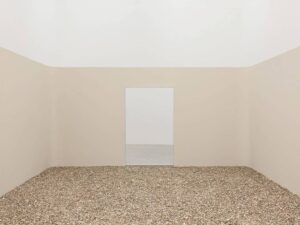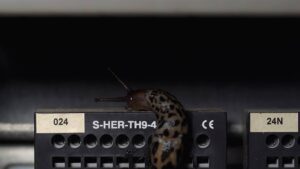
Nina Canell, Drag Out, 2021, synthetic rubber, synthetic polymer Photo:© Antonio Maniscalco
Nina Canell’s Tectonic Tender at Berlinische Galerie
by Christian Hain

Just in time for Berlin Gallery Weekend – which happened again almost as normal this year, Berlinische Galerie opened a small exhibition by Swedish artist Nina Canell. The long and narrow corridor that often hosts installations here poses a special challenge to artists, not least because visitors may enjoy the bird’s view perspective from the museum’s upper levels. Canell chose a new embodiment of the ephemeral seafood installation Muscle Memory that she first served in 2021 and the title left us wondering whether there might have been some mishearing involved – could she have said ‘Mussel’ (?) then decided to stay with muscles.
The installation consists of a big sandbox held together by light partition walls that are remotely reminiscent of a shipping container – not filled with sand but its earlier state of matter: Seven tons of mollusc shells from the North Sea, mostly mussels. Visitors take a walk inside and crunch them under their feet, thus destroying the creation by their mere presence. Like a stone desert, shades of grey dominate and we’re told, no molluscs have been harmed for the art: Dedicated companies pillage the ocean floor and sell the resource to makers of building materials who use it in concrete – and also to the odd artist.
The art collector’s connoisseur eye will detect a handful of oyster shells hidden among the remains whereas we espied, and touched, mere pebbles too (those companies’ small print probably mentions, ‘may contain traces of inorganic mater’). At least all (micro-)plastic and oil chunks have been filtered out. In a way, Muscle Memory works as a sound installation, the slow but inevitable destruction of the work by admirers, viz. museum-goers, won’t happen in silence, on the contrary, their every step is audible from afar. Is this the sea crying of pain, a swan song metaphorically speaking?
Numerous iron tubes that cannot all be needed for technical reasons keep the sandbox in place. They hint at a scrap press, which would accelerate the process of smashing the shells. The wall panels display a lot of technical information, the manufacturer’s name (a company called ‘de Konig’,) Anyway, although we see and hear the art under our feet, we don’t smell the sea, and lifting a specimen to our ear, we cannot hear it either.
A museum representative tells of intrusions into nature that ‘prevent the ocean from healing itself’ but won’t provide any more detail. Today everybody’s supposed to know, i.e. ‘feel’, that man can only ever be an intruder and destroyer of nature, which might be a little over simplistic. Gladly, this installation and the exhibition as a whole don’t appear too one-dimensional, no in-your-face propaganda as is sadly often the case with environmentalist art.
“We break stuff to make stuff”, says the artist, and, well, isn’t that nature’s most basic law? Everything changes, Samsara in Buddhism, and without death there can be no (re)birth. Nature formed these shells, indeed. But she’s also shed them. Walking on broken shells, our feet are protected by technology, by shoes that ‘man, the deficient being’ (A. Gehlen) made from (more or less) organic matter: Technology is our shell, our snail house.
Some crushed mollusc shells will eventually turn to sand, others dating from prehistoric times can still be found in deserts today where there was once an ocean. New deserts might be a result of the global climate changing again like it did so often before – simultaneously turning deserts into rain forests with all the biodiversity that is characteristic of warmer times as opposed to cold periods. Yet, human civilisation might not be able to cope; ‘nature’ is literally everything that happens on this planet, and it will survive everything we do without a doubt.

Leaving the installation, some pieces stick to our soles and break with a different sound, while we take a look at the rest of the show: A video on a large screen features an unexpectedly beautiful slug creeping over some technical apparatus and no, that’s not slow motion. The images change to the same Hong Kong skyscraper with a drive-through hole for dragons on a road trip that we’ve seen in Berlin before, in American/Chinese artist collective Wang Shui’s exhibition at Stoschek Collection 2019. Is this every little slug’s dream: to grow wings like a proper lindworm? Might tell something about humanity, too: from slug’s speed to High Tech and yet there’s still some invertebrate in us, at least as long as we believe in our ‘dragons’. Despite all modern technological wizardry, the average Chinese still clings on to his old-fashioned truths, not only (and of course only meant symbolically) dragons but also Feng Shui building techniques. I’m not sure, if you should mock this, isn’t it rather refreshing and reassuring to learn, that locals hold a Sir Norman Forster designed skyscraper accountable for bankruptcies because the chang bi zi (long nose) didn’t follow those rules? The totalitarianism of science enforcing only one mathematical truth for the whole world is so boring and ultimately futile, limiting human might and impoverishing world and mind alike. When all’s said and done, who’d cares about truth?
Only when the Chinese dragon coughs, you’d better run as fast you can these days.
The film closes with images of a lonely plant in a potentially not species-appropriate bucket, controlled by man who in a way has created its life. Slug life. Around the screen, we find cut parts of cables that once lay buried 20.000 miles under the sea to facilitate human communication and in this new context, they resemble dead giant molluscs.
Canell says, she regularly uses naturally found materials in her art (for example in a little sculpture next to the door). Upon entry we noted, ‘splattered death star with a water balloon, or amphora putting its tongue out’, but having seen the installation, it seems more like – well, you’ve guessed it: another, and rather large, mollusc; hit by a water balloon. All parts of the assemblage have washed on shore before the artist found and gave them new life in a new form.

Let’s get back to the interpretation: The entire exhibition’s title is Tectonic Tender, and we immediately think of a tenderly destructive hate-love relationship between Man and Mother Earth – make no mistake, this really goes both ways: nature’s out to get you (if not with a lion, than with a virus; earthquakes are naturally deadly, too) forever feeding on herself. It’s called the circle of life.
Yet there are more meanings to the term tender. Beside the thoroughly fashionable view of man only ever being of an invasive and destructive nature, there’s the more conventional one of a warden, a forester, ‘(at-)tending’ to nature, but the role of a predator to regulate overpopulations is often ignored (while the overpopulation of humanity itself lies at the core of so many problems, and gets hardly ever addressed). Paradoxically, those who cry for the protection of nature the loudest and mourn its every change, abstract it the most, putting themselves out of the circle, as if man were an alien without a role to play in this planet’s ecosystem.
Outside again, we noticed a familiar but different feeling under our feet, once more crushing organic structures. Looking down, we discovered ant colonies breaking through the pavement and (involuntarily) building pyramids of sand. Sometimes, an exhibition stays with you even after you’ve left the gallery.
Nina Canell, Tectonic Tender, 30 April-22 August 2022, Berlinische Galerie

